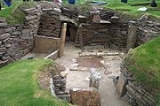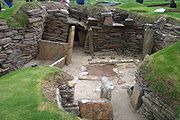
32nd century BC
Encyclopedia
Events

- c. 3150 BC: NarmerNarmerNarmer was an ancient Egyptian pharaoh of the Early Dynastic Period . He is thought to be the successor to the Protodynastic pharaohs Scorpion and/or Ka, and he is considered by some to be the unifier of Egypt and founder of the First Dynasty, and therefore the first pharaoh of unified Egypt.The...
(First Dynasty) started to rule in Ancient EgyptAncient EgyptAncient Egypt was an ancient civilization of Northeastern Africa, concentrated along the lower reaches of the Nile River in what is now the modern country of Egypt. Egyptian civilization coalesced around 3150 BC with the political unification of Upper and Lower Egypt under the first pharaoh...
. - c. 3125 BC: Narmer died.
- 3102 BC: The Beginning of Kali YugaKali YugaKali Yuga is the last of the four stages that the world goes through as part of the cycle of yugas described in the Indian scriptures. The other ages are Satya Yuga, Treta Yuga and Dvapara Yuga...
according to VedicVedicVedic may refer to:* the Vedas, the oldest preserved Indic texts** Vedic Sanskrit, the language of these texts** Vedic period, during which these texts were produced** Vedic pantheon of gods mentioned in Vedas/vedic period...
Scriptures. - Varna NecropolisVarna NecropolisThe Varna Necropolis is a burial site in the western industrial zone of Varna , Bulgaria, internationally considered one of the key archaeological sites in world prehistory...
: what have been claimed to be the earliest-known worked gold artifacts are manufactured. - MaltaMaltaMalta , officially known as the Republic of Malta , is a Southern European country consisting of an archipelago situated in the centre of the Mediterranean, south of Sicily, east of Tunisia and north of Libya, with Gibraltar to the west and Alexandria to the east.Malta covers just over in...
: Construction of the Ħaġar Qim megalithic temples, featuring both solar and lunar alignments. "Tarxien period" of megalithic temple construction reaches its apex. - Ancient EgyptAncient EgyptAncient Egypt was an ancient civilization of Northeastern Africa, concentrated along the lower reaches of the Nile River in what is now the modern country of Egypt. Egyptian civilization coalesced around 3150 BC with the political unification of Upper and Lower Egypt under the first pharaoh...
: Earliest known Egyptian hieroglyphs, beginning of the Early Dynastic Period of EgyptEarly Dynastic Period of EgyptThe Archaic or Early Dynastic Period of Egypt immediately follows the unification of Lower and Upper Egypt c. 3100 BC. It is generally taken to include the First and Second Dynasties, lasting from the Protodynastic Period of Egypt until about 2686 BC, or the beginning of the Old Kingdom...
. - CreteCreteCrete is the largest and most populous of the Greek islands, the fifth largest island in the Mediterranean Sea, and one of the thirteen administrative regions of Greece. It forms a significant part of the economy and cultural heritage of Greece while retaining its own local cultural traits...
: Rise of Minoan civilizationMinoan civilizationThe Minoan civilization was a Bronze Age civilization that arose on the island of Crete and flourished from approximately the 27th century BC to the 15th century BC. It was rediscovered at the beginning of the 20th century through the work of the British archaeologist Arthur Evans...
. - NeolithicNeolithicThe Neolithic Age, Era, or Period, or New Stone Age, was a period in the development of human technology, beginning about 9500 BC in some parts of the Middle East, and later in other parts of the world. It is traditionally considered as the last part of the Stone Age...
settlement built at Skara BraeSkara BraeSkara Brae is a large stone-built Neolithic settlement, located on the Bay of Skaill on the west coast of Mainland, Orkney, Scotland. It consists of ten clustered houses, and was occupied from roughly 3180 BCE–2500 BCE...
in the Orkney IslandsOrkney IslandsOrkney also known as the Orkney Islands , is an archipelago in northern Scotland, situated north of the coast of Caithness...
, ScotlandScotlandScotland is a country that is part of the United Kingdom. Occupying the northern third of the island of Great Britain, it shares a border with England to the south and is bounded by the North Sea to the east, the Atlantic Ocean to the north and west, and the North Channel and Irish Sea to the...
. (pictured) - New Stone Age people in IrelandIrelandIreland is an island to the northwest of continental Europe. It is the third-largest island in Europe and the twentieth-largest island on Earth...
build the 250,000 ton (226,796.2 tonne) NewgrangeNewgrangeNewgrange is a prehistoric monument located in County Meath, on the eastern side of Ireland, about one kilometre north of the River Boyne. It was built around 3200 BC , during the Neolithic period...
solar oriented passage tomb. - c. 3100 BC: The earliest phase of StonehengeStonehengeStonehenge is a prehistoric monument located in the English county of Wiltshire, about west of Amesbury and north of Salisbury. One of the most famous sites in the world, Stonehenge is composed of a circular setting of large standing stones set within earthworks...
construction begins.
Significant persons
- NarmerNarmerNarmer was an ancient Egyptian pharaoh of the Early Dynastic Period . He is thought to be the successor to the Protodynastic pharaohs Scorpion and/or Ka, and he is considered by some to be the unifier of Egypt and founder of the First Dynasty, and therefore the first pharaoh of unified Egypt.The...
, successor of King ScorpionKing ScorpionScorpion, or Selk, also King Scorpion or Scorpion II refers to the second of two kings so-named of Upper Egypt during the Protodynastic Period. Their names may refer to the scorpion goddess Serket...
and founder of the First dynasty of EgyptFirst dynasty of EgyptThe first dynasty of Ancient Egypt is often combined with the Dynasty II under the group title, Early Dynastic Period of Egypt...
Calendar epochs
- 3114 BC—According to the most widely accepted correlations between the Western calendar and the calendar systems of pre-ColumbianPre-ColumbianThe pre-Columbian era incorporates all period subdivisions in the history and prehistory of the Americas before the appearance of significant European influences on the American continents, spanning the time of the original settlement in the Upper Paleolithic period to European colonization during...
MesoamericaMesoamericaMesoamerica is a region and culture area in the Americas, extending approximately from central Mexico to Belize, Guatemala, El Salvador, Honduras, Nicaragua, and Costa Rica, within which a number of pre-Columbian societies flourished before the Spanish colonization of the Americas in the 15th and...
, the mythical starting point of the current Mesoamerican Long Count calendarMesoamerican Long Count calendarThe Mesoamerican Long Count calendar is a non-repeating, vigesimal and base-18 calendar used by several Pre-Columbian Mesoamerican cultures, most notably the Maya. For this reason, it is sometimes known as the Maya Long Count calendar...
cycle occurs in this year. The Long Count calendar, used and refined most notably by the Maya civilizationMaya civilizationThe Maya is a Mesoamerican civilization, noted for the only known fully developed written language of the pre-Columbian Americas, as well as for its art, architecture, and mathematical and astronomical systems. Initially established during the Pre-Classic period The Maya is a Mesoamerican...
but also attested in some other (earlier) Mesoamerican cultures, consisted of a series of interlocked cycles or periods of day-counts, which mapped out a linear sequence of days from a notional starting point. The system originated sometime in the Mid- to Late Preclassic period of Mesoamerican chronologyMesoamerican chronologyMesoamerican chronology divides the history of pre-Columbian Mesoamerica into several periods: the Paleo-Indian , the Archaic , the Preclassic , the Classic , and the Postclassic...
, during the latter half of the 1st millennium BC. The starting point of the most commonly used highest-order cycle—the b'ak'tun-cycle consisting of thirteen b'ak'tuns of 144,000 days each—was projected back to an earlier, mythical date. This date is equivalent to 11 August 3114 BC in the proleptic Gregorian calendarProleptic Gregorian calendarThe proleptic Gregorian calendar is produced by extending the Gregorian calendar backward to dates preceding its official introduction in 1582.-Usage:...
(or 6 September in the proleptic Julian calendarProleptic Julian calendarThe proleptic Julian calendar is produced by extending the Julian calendar to dates preceding AD 4 when its quadrennial leap year stabilized. The leap years actually observed between its official implementation in 45 BC and AD 4 were erratic, see the Julian calendar article for details.A calendar...
), using the correlation known as the "Goodman-Martinéz-Thompson (GMT) correlation". The GMT-correlation is worked out with the Long Count starting date equivalent to the Julian Day Number (JDN) equal to 584283, and is accepted by most MayanistMayanistA Mayanist is a scholar specialising in research and study of the Central American pre-Columbian Maya civilization. This discipline should not be confused with Mayanism, a collection of New Age beliefs about the ancient Maya....
scholars as providing the best fit with the ethnohistorical data. Two succeeding dates, the 12th and 13 August (Gregorian) have also been supported, with the 13th (JDN = 584285, the "astronomical" or "Lounsbury" correlation) attracting significant support as according better with astronomical observational data. Although it is still contended which of these three dates forms the actual starting base of the Long Count, the correlation to one of this triad of dates is definitively accepted by almost all contemporary Mayanists. All other earlier or later correlation proposals are now discounted. The end of the thirteenth baktun is either on December 21 or 23 of 2012.

